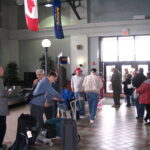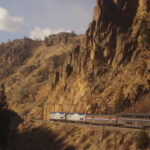Late Trains are Everyone’s Problem.
There’s a very interesting map of North America that follows the movements of all passenger trains for both Amtrak and VIA Rail in Canada. It’s constantly up-dated throughout the day so you can see what progress each train is making . . . or not making, as is often the case. This is a link to the map.
Spend any time with this map and you will soon see that when it comes to passenger trains running on time, there are good days and there are bad days. And it is an unfortunate reality that often the good days are not good at all, and the bad days . . . well, they’re really bad!
I spent some time on the map a couple of weeks ago. It was late afternoon here in Hawaii, which means it was probably around 10:00 p.m. on the East Coast.
I wanted to see how many of Amtrak’s long-distance trains were running close to on-time. Essentially, what I got was an electronic snapshot, taken when some of the trains were nearing the end of their routes while others were halfway through or just beginning theirs.
Let me emphasize that while the “results” are interesting, this was not real science. It was a one-time sample from which only one conclusion can be drawn: that a real problem does indeed exist. That said, here are a few specific performance take-aways from the small sample I took.
* Only one long-distance train was running on time. That was the Lake Shore Limited, heading west from Albany, New York, en route to Chicago.
* Of all the remaining long-distance trains, the northbound Crescent, en route from New Orleans to New York and only a few hours into its route, was already 54 minutes behind schedule. Put another way, the Amtrak train with the second best on-time record for that day was running almost an hour late.
The worst? That “honor” goes to the southbound Crescent. At the time, still probably 200 miles from the end of its route in New Orleans, this train was running more than four-and-a-half hours behind schedule.
Of all the long-distance passenger trains operating on that one day:
* one train had arrived on time
* one train’s arrival time had not been recorded
* twelve trains, most still en route, were running a total of 38 hours late.
What you and I don’t know, and what government regulators need to know, is how many of those 38 hours of delay were caused by dispatchers for the freight railroads giving their company trains preference over Amtrak trains.




It should be noted that track capacity is limited, sidings are often not at the 10,000 foot+ length of the Intermodal Freights of today, and often times this is what forces Amtrak trains “into the hole”. A new government mandate would be useless without significant funding to unsnarl the great transcontinentals and add many more miles of mainline track, sidings, and universal crossovers.